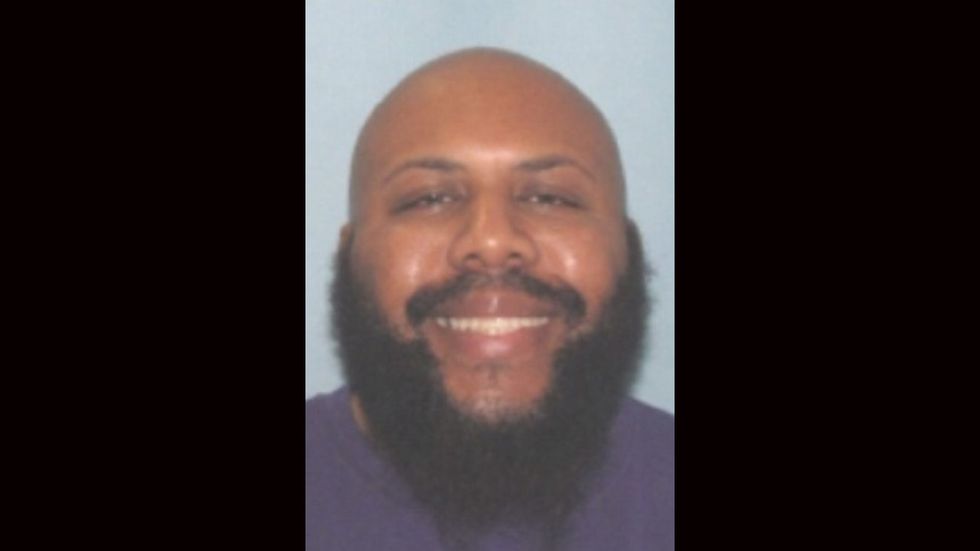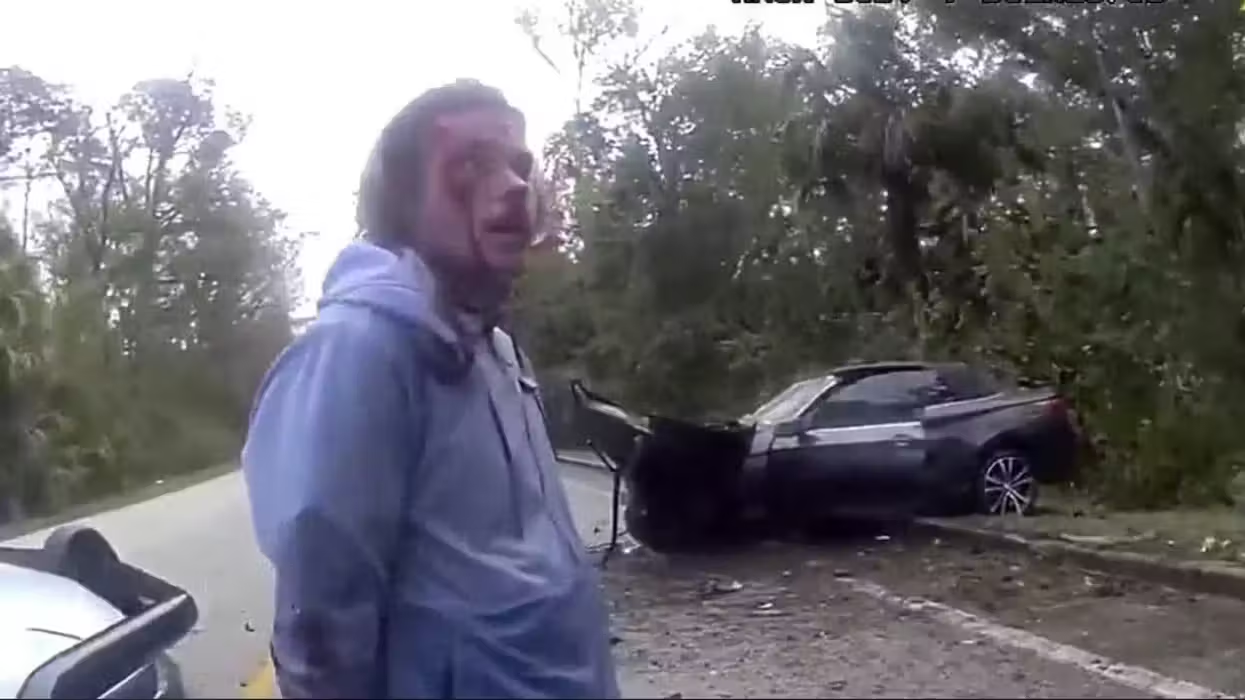
© 2025 Blaze Media LLC. All rights reserved.
A manhunt is underway in Cleveland, Ohio for a man suspected of murdering an elderly citizen in cold blood and streaming his crime on Facebook Live, Sunday afternoon. The crime is barbaric. It is uniquely narcissistic. And, perhaps worse of all, the video has gone viral ... which means the video has an audience.
This is the latest in a series of violent crimes streamed using Facebook’s Live video feature.
Police are searching for Steve Stephens, who goes by the name “Stevie Steve,” in connection with the murder of 74-year-old Robert Godwin Sr., who was killed — apparently at random — as thousands watched his death live-streamed on social media.
Cleveland police confirmed that a FB Live video posted to Stephens’ account showing Godwin being shot is legitimate. The extremely graphic video depicts Stephens in his vehicle saying “[Found me] somebody I’m about to kill. Imma kill this guy right here.”
He then proceeds to exit his vehicle and walks up to Godwin, asking him how old he is before pulling out his weapon. Stephens asks Godwin to repeat the name of his ex-girlfriend and then proceeds to shoot the old man in the head explaining that “she’s the reason this is about to happen to you.” As if he can justify his heinous acts by blame casting.
Rest in Peace Mr. Godwin who died in the senseless #Cleveland shooting today. pic.twitter.com/mEqOmuPnKG
— David Sammon (@iamtheceo) April 16, 2017
Stephens has reportedly claimed online to have killed 15 people, according to The Sun. Police have confirmed only one victim.
“We need Steve to turn himself in,” Cleveland Police Chief Calvin Williams said at a press conference. “Right now there are two families out there hurting. Mr. Godwin’s family and of course there are people out there who care about Steve and want to see this not go any further.
“We’ve brought everything to bear on this, from our federal partners, our state and local partners. And everybody is out there looking for Steve. We want this to end with as much peace as we can bring to this right now,” Williams said.
“What happened today is senseless,” he added.
Family members of the victim, Robert Godwin Sr., spoke to local news outlets. “He’s a good guy,” one said. “He’d give you the shirt off his back.”
I just spoke with a man and woman who said the man killed in the FB live video was their 78 year old father @cleveland19news pic.twitter.com/Gpf3EUafLM
— Shanice (@ShaniceDunning) April 16, 2017
“This man right here was a good man. And I just hate, I hate he’s gone. It’s not real.”
Why did this happen? Why is a good man dead?
A manifesto of sorts for Stephens’ crimes comes from his Facebook page, in both posts and videos which have since been taken down. The alleged killer blames his ex-girlfriend of three years for driving him “crazy.” He claims to have ruined his life with gambling and bankruptcy. He rails against a job he hates. He demands that innocent people die because no one “cares” for his problems. “We are all human and we all have breaking points,” he says.
He has killed and used social media for attention and sympathy. He’s certainly obtained the former. God forbid he obtains the later. But he is not alone. Stephens’ crimes are the latest in a series of brutal crimes and acts of violence that have been posted to the internet using Facebook’s live video feature.
In early January, four Chicago teens kidnapped a developmentally disabled man. They bound him and streamed his torture on Facebook Live as they shouted things like “F—k white people!” and “F—k Donald Trump!” The four African American assailants were later arrested and charged with hate crimes.
Later that month, a 14-year-old Florida girl broadcast her suicide in a live stream posted to Facebook. Hundreds of viewers were watching that video, including the girl’s friends who were pleading for her not to take her life. Other viewers mocked her and urged her to kill herself, calling her vile names and claiming her video was “fake” or “all an act.” The girl’s own mother was one of those accused of taunting her.
In February, three migrant men — two from Afghanistan and one from Iran — were arrested in Sweden on suspicion of raping a woman and broadcasting it on Facebook Live. A similar attack took place two weeks earlier, and was also filmed and posted to social media.
In March, five to six Chicago men were suspected by police of sexually assaulting a 15-year-old girl and streaming the attack on Facebook. Two suspects — both minors — are now in custody for the assault that 40 people watched in real time. None of those viewers reported the attack to police.
These crimes are disturbing. They show that in some cases, social media is being used as a medium to exhibit incredible acts of evil for the sick pleasure of wicked men and women. Or, in the tragic case of the young teen who committed suicide as her viewers egged her on, they show that there is an audience for such evil. An eager one.
Facebook itself obviously opposes such an abuse of their platform. A statement released by Facebook reiterates that the content in Stephens’ video and previous posts violates Facebook’s community standards, as do the other crimes.
“This is a horrific crime and we do not allow this kind of content on Facebook,” a spokeswoman for Facebook said, according to CNN.
Facebook statement on Cleveland shooting video: "This is a horrific crime and we do not allow this kind of content" https://t.co/G8mpL2QxfI
— Brian Stelter (@brianstelter) April 16, 2017
“We work hard to keep a safe environment on Facebook, and are in touch with law enforcement in emergencies when there are direct threats to physical safety.”
But has Facebook done enough? Can they do enough?
Consider, what is the good of providing attention-seeking evildoers with an easy way to find a widespread audience? The criminals get what they want. The have an incentive to commit their crimes because they know they will find easy infamy.
Facebook surely has a responsibility to police the content on their platform, and it is good that they are working with law enforcement to catch the criminals that abuse their features. Ultimately however, Facebook’s power to control how its community behaves is limited. Could, for example, they design an algorithm to identify posts about violence and remove them? Potentially, but such an algorithm would have flaws.
Should Facebook remove the tools these criminals are using to draw attention to their evil? That would be an easy answer if Facebook Live were solely responsible for feeding the egos of those that abuse it. But Facebook does not bear the sole responsibility for encouraging heinous acts like Stephens’. The community of users who watch and share torture porn are just as responsible.
Indeed, the responsibility for the use of social media is fundamentally that of its users. That Stephens’ videos were viewed and shared so widely speaks poorly of our culture. Ask yourself, why share a video of a man being shot in the face? Why draw attention to it?
Why do some cheer on the girl who hangs herself with a scarf?
There are no easy answers to these questions.
The exposition of violent crime. The advent of cyber-bullying. Even flame wars over political discussions that drive apart families and friends. There is a clearly a cost to using social media.
Perhaps it’s time to ask if it is worth it?
Stephens remains at large. He is considered armed and dangerous. Police say if he is seen, “call 9-1-1. Do not approach.”
Editor's note: Updated reports indicate the victim was Robert Godwin Sr., not Robert Goodwin Sr. This article has been updated to correct the misspelling. We regret the error.
Want to leave a tip?
We answer to you. Help keep our content free of advertisers and big tech censorship by leaving a tip today.
Want to join the conversation?
Already a subscriber?
more stories
Sign up for the Blaze newsletter
By signing up, you agree to our Privacy Policy and Terms of Use, and agree to receive content that may sometimes include advertisements. You may opt out at any time.
Related Content
© 2025 Blaze Media LLC. All rights reserved.
Get the stories that matter most delivered directly to your inbox.
By signing up, you agree to our Privacy Policy and Terms of Use, and agree to receive content that may sometimes include advertisements. You may opt out at any time.






